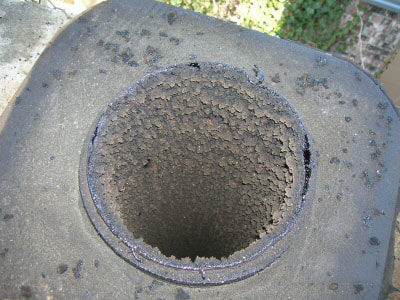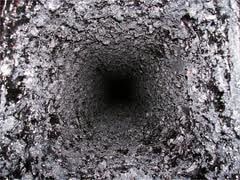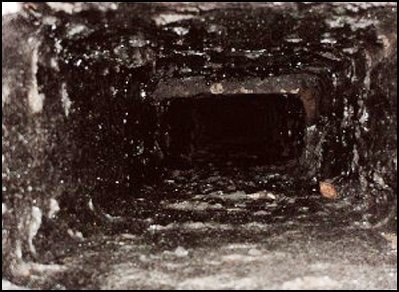Types of Creosote
he Three Types of Creosote, from Least to Most Dangerous
Did you know that whenever you burn wood in your fireplace, creosote is deposited in the chimney lining? “Creosote” is the name used for wood-burning byproducts, and it consists of a mix of creosote, tar, and soot. Creosote buildup in your chimney has three degrees, each different from the other and each more difficult to clean and potentially more hazardous than the previous degree. Possibly the most important reason to get an annual chimney sweeping and inspection is to prevent chimney fires caused by creosote.
1st Degree Creosote
The type of buildup you want in your chimney liner is first degree creosote. This type has high soot content and can be easily removed with a basic chimney brush. (Poly or wire)
First degree creosote is produced when the flue is warmed by the fire’s heat, there is good wood combustion, and the fire gets plenty of air. The best way to achieve good wood combustion is to burn hot, and only well seasoned firewood; when firewood is seasoned, it has low moisture content. Houses today are often sealed too tightly, which can cause the air supply in the fireplace to be restricted, which in turn causes smoke to enter the home and prevents the flue from warming properly.
2nd Degree Creosote
A chimney which has a restricted amount of incoming air sets up the right conditions to produce the second degree of creosote. Restricted air is commonly caused by fireplaces and wood stoves that have glass doors. This degree of creosote looks like glistening black flakes. (Burnt Popcorn) The flakes contain hardened tar,
and they are not easily brushed away.
Removing creosote is essential for safety reasons, but achieving it is only easy with first degree creosote. A Rotary Sweeping is most often used to remove second degree creosote. This equipment consists of a stainless steel cable attached to a hub which has metal rods that are turned by a special type of power drill. Some people believe that a rotary cable damages their chimney liner, this is not true. Reality is the liner has already been damaged and the cable knocks the creosote loose to prevent further damage.
3rd Degree Creosote
Third degree creosote is extremely concentrated fuel that looks like tar running down
or coating the inside of the chimney. The creosote hardens and is repeatedly recoated. If the creosote in the liner catches fire, third degree creosote may burn up, but it usually does not. Instead, the creosote partly boils and partly burns, leaving a light-weight “sponge” that is simple to remove. However, if it is not swept and creosote fills the spongy substance, your chimney can end up with 100 pounds or more of creosote and a highly combustible chimney.
Some of the conditions which cause third degree creosote are:
Cleaning third degree creosote is very difficult, and the best course of action is often to simply reline the chimney. Options for removing the most difficult degree of creosote include performing a Rotary Sweeping with chains and using chemical creosote removers.
Did you know that whenever you burn wood in your fireplace, creosote is deposited in the chimney lining? “Creosote” is the name used for wood-burning byproducts, and it consists of a mix of creosote, tar, and soot. Creosote buildup in your chimney has three degrees, each different from the other and each more difficult to clean and potentially more hazardous than the previous degree. Possibly the most important reason to get an annual chimney sweeping and inspection is to prevent chimney fires caused by creosote.
1st Degree Creosote
The type of buildup you want in your chimney liner is first degree creosote. This type has high soot content and can be easily removed with a basic chimney brush. (Poly or wire)
First degree creosote is produced when the flue is warmed by the fire’s heat, there is good wood combustion, and the fire gets plenty of air. The best way to achieve good wood combustion is to burn hot, and only well seasoned firewood; when firewood is seasoned, it has low moisture content. Houses today are often sealed too tightly, which can cause the air supply in the fireplace to be restricted, which in turn causes smoke to enter the home and prevents the flue from warming properly.
2nd Degree Creosote
A chimney which has a restricted amount of incoming air sets up the right conditions to produce the second degree of creosote. Restricted air is commonly caused by fireplaces and wood stoves that have glass doors. This degree of creosote looks like glistening black flakes. (Burnt Popcorn) The flakes contain hardened tar,
and they are not easily brushed away.
Removing creosote is essential for safety reasons, but achieving it is only easy with first degree creosote. A Rotary Sweeping is most often used to remove second degree creosote. This equipment consists of a stainless steel cable attached to a hub which has metal rods that are turned by a special type of power drill. Some people believe that a rotary cable damages their chimney liner, this is not true. Reality is the liner has already been damaged and the cable knocks the creosote loose to prevent further damage.
3rd Degree Creosote
Third degree creosote is extremely concentrated fuel that looks like tar running down
or coating the inside of the chimney. The creosote hardens and is repeatedly recoated. If the creosote in the liner catches fire, third degree creosote may burn up, but it usually does not. Instead, the creosote partly boils and partly burns, leaving a light-weight “sponge” that is simple to remove. However, if it is not swept and creosote fills the spongy substance, your chimney can end up with 100 pounds or more of creosote and a highly combustible chimney.
Some of the conditions which cause third degree creosote are:
- - When combustion is incomplete and/or the flue isn’t sufficiently warmed
- - The chimney is not insulated or is too cold for other reasons
- - Unseasoned wood is being burned
- - The house is sealed to tight that there is an insufficient amount of combustion air
- - The flue is too big
Cleaning third degree creosote is very difficult, and the best course of action is often to simply reline the chimney. Options for removing the most difficult degree of creosote include performing a Rotary Sweeping with chains and using chemical creosote removers.
- Dr. Soot 'n Cinder has the knowledge and skill to remove all degrees of creosote, but we highly recommend sweeping the chimney annually, to avoid the dangers and difficulties associated with third degree creosote.


